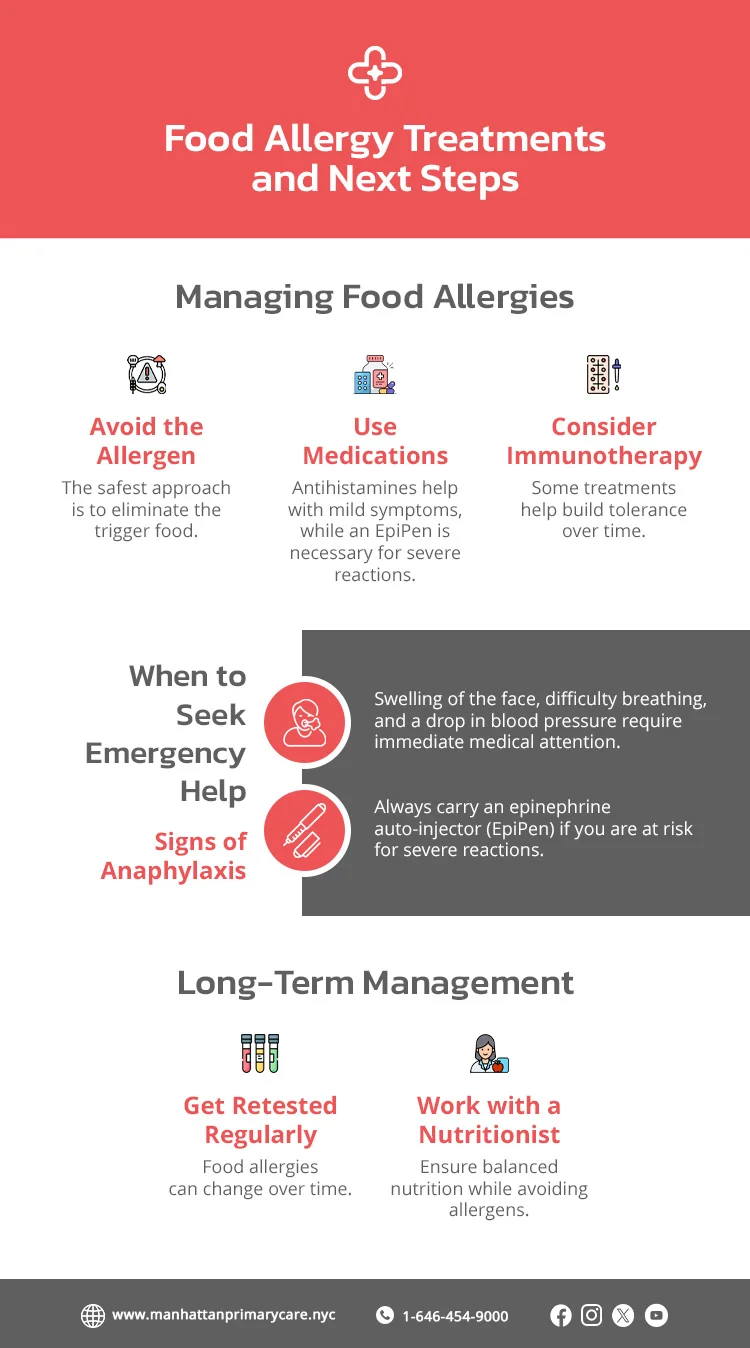Food allergies are becoming more common, affecting both kids and adults. If you or a loved one has ever experienced an allergic reaction, you know how important it is to get the right diagnosis. The first step is understanding the difference between food allergies and food intolerances. While food allergies trigger a serious immune response, food intolerances mainly cause digestive discomfort and aren’t life-threatening.
What Are Food Allergies and How Do They Differ from Food Intolerances?
Food Allergies
A food allergy happens when your immune system mistakenly thinks a certain food is harmful and overreacts. The symptoms can range from mild, like itchy skin, to life-threatening anaphylaxis. Common signs include:
- Skin reactions: Red, itchy rashes or hives
- Digestive problems: Nausea, vomiting, or diarrhea
- Breathing issues: Wheezing or difficulty breathing
- Severe reactions: Swelling of the face or throat, requiring emergency care
Food Intolerances
Food intolerances don’t involve the immune system. Instead, they occur when your body has trouble digesting certain foods, like dairy or gluten. Symptoms typically include bloating, stomach pain, and gas but are not life-threatening.
Because food allergies can be dangerous, accurate testing is essential to pinpoint the cause and create a management plan.
How to Test for Food Allergies
Common Allergy Tests
Doctors use different methods to diagnose food allergies. Here are the most reliable ones:
- Skin Prick Test (SPT): Identifies immediate allergic reactions.
- Blood Test (IgE Test): Measures immune response to specific foods.
- Patch Test: Helps detect delayed skin reactions.
- Elimination Diet & Oral Food Challenge: The most accurate way to confirm an allergy.
How Each Test Works
1. Skin Prick Test (SPT)
- How it’s done: A tiny amount of allergen is placed on your skin, usually on your forearm or back. The skin is then lightly pricked to let the allergen in.
- What it tells you: If you develop redness or swelling, you may have an allergy.
- What to keep in mind: False positives can happen, so follow-up testing may be needed.
2. Blood Test (IgE Test)
- How it’s done: A blood sample is taken to measure IgE antibodies against specific foods.
- What it tells you: High IgE levels suggest a possible allergy.
- What to keep in mind: Results can take a few days and may require further testing.
3. Patch Test
- How it’s done: Small amounts of allergens are placed on patches and stuck to your skin for 48 hours.
- What it tells you: Helps identify delayed allergic reactions.
- What to keep in mind: More useful for skin allergies than food allergies.
4. Elimination Diet & Oral Food Challenge
- How it’s done: You stop eating a suspected food for a while, then slowly reintroduce it under medical supervision.
- What it tells you: This is the most accurate test to confirm food allergies.
- What to keep in mind: Requires strict medical oversight due to the risk of severe reactions.
How Does Allergy Testing Work?
What to Expect During a Test
Food allergy testing involves controlled exposure to potential allergens while monitoring your reaction. Some tests take just minutes, while others, like patch tests, require several days. Avoid antihistamines before testing, as they can affect the results.
Who Should Get Tested?
If you frequently experience unexplained rashes, hives, stomach issues, or breathing problems, you should consider getting tested. Kids with a family history of allergies may also benefit from early screening.
How Accurate Are These Tests?
While skin and blood tests are useful, they aren’t perfect—false positives happen. The oral food challenge is the most accurate way to diagnose a food allergy.
What Is the Most Reliable Food Allergy Test?
The oral food challenge is the best way to confirm a food allergy because it tests your body’s direct reaction under controlled conditions. However, because it carries a risk of severe reactions, it must be done by a medical professional.
At-Home vs. Clinical Testing
At-home food sensitivity tests may seem convenient, but they aren’t as reliable as clinical allergy tests. These tests measure IgG antibodies, which don’t necessarily indicate a true allergy. For accurate results, always consult an allergist.
Common Misconceptions
- “Food sensitivity tests can diagnose allergies.” → False. Sensitivity tests measure IgG, not IgE, which is what causes allergies.
- “A positive skin or blood test confirms an allergy.” → Not always. False positives are common, and further testing is often needed.
Food Allergy Treatments and Next Steps


Managing Food Allergies
- Avoid the allergen: The safest approach is to eliminate the trigger food.
- Use medications: Antihistamines help with mild symptoms, while an EpiPen is necessary for severe reactions.
- Consider immunotherapy: Some treatments help build tolerance over time.
When to Seek Emergency Help
- Signs of anaphylaxis: Swelling of the face, difficulty breathing, and a drop in blood pressure require immediate medical attention.
- Always carry an epinephrine auto-injector (EpiPen) if you are at risk for severe reactions.
Long-Term Management
- Get retested regularly: Food allergies can change over time.
- Work with a nutritionist: Ensure balanced nutrition while avoiding allergens.
Conclusion
Understanding your food allergies can make life easier and safer. At Manhattan Primary Care, we offer comprehensive allergy testing to help you identify triggers and manage symptoms effectively. Whether through skin tests, blood tests, or oral food challenges, our specialists ensure you get the most accurate diagnosis.
Don’t rely on self-diagnosis or at-home tests—get expert guidance. If you suspect a food allergy, schedule an appointment with a trusted healthcare provider to take control of your health and well-being.
Frequently Asked Questions
Can stress or anxiety trigger or worsen food allergies?
Stress doesn’t cause food allergies but can worsen reactions by increasing inflammation and mimicking symptoms like itching or nausea.
Are there early warning signs before a severe allergic reaction?
Yes, mild itching, tingling in the mouth, or lip swelling can appear before a severe reaction. Recognizing them early helps prevent escalation.
Why do some children outgrow food allergies while others don’t?
It depends on the type of allergy, immune system development, and genetics. Milk, egg, and wheat allergies are often outgrown, but peanut and shellfish allergies are less likely to fade.
Can airborne exposure trigger food allergies?
Rarely, but highly sensitive individuals may react to cooking vapors or airborne food proteins, especially from peanuts or shellfish.
Are organic or non-GMO foods safer for allergies?
No, food allergies are caused by proteins, not farming methods. Always check labels for potential allergens, even in organic foods.
Can vaccines trigger food allergies?
Vaccines don’t cause food allergies, but some contain egg proteins (e.g., flu vaccine), which may affect people with severe egg allergies.
Disclaimer
This blog is for informational & educational purposes only and does not intend to substitute any professional medical advice or consultation. For any health-related concerns, please consult with your physician, or call 911.
